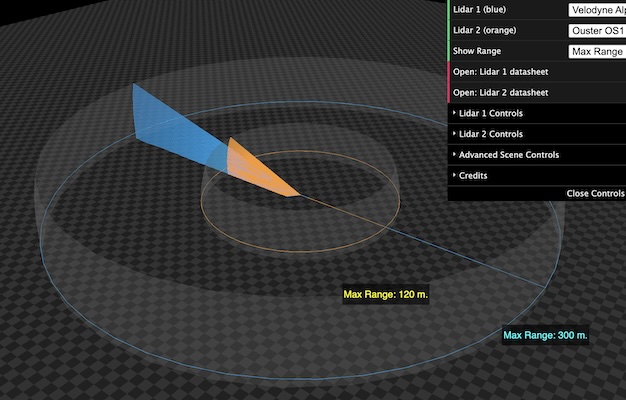|
Listen to this article |

A screenshot of Tangram Vision’s LiDAR comparison tool
Light Detection and Ranging (LiDAR) is a sensing method that uses light in the form of a pulsed laser to measure distance. LiDAR is useful in autonomy for a number of key functions such as obstacle avoidance, object detection, and object identification. The 3D data from spinning LiDAR is often a key input into navigational systems for autonomous vehicles and robots.
If you’re searching for a LiDAR sensor to add to your robot, Tangram Vision wants to make your evaluation process simpler. Tangram Vision, a startup building software and hardware for robotic perception, just launched an interactive tool called “Spinning LiDAR Visualizer” that lets you compare spinning LiDAR models.
Users can compare 28 LiDAR models from leading manufacturers such as Hesai, Ouster, Quanergy, RoboSense, and Velodyne. The visualizer allows you to select 1-2 LiDAR sensors to analyze and compare maximum range, range at 10% reflectivity, angular resolution, and field of view. You can click and drag for different viewpoints, embed the tool somewhere else, or even modify it on GitLab.
“From day one, our goal for Tangram Vision has been to build the tools and resources we always wished we’d had as perception engineers,” said Tangram Vision COO & Co-founder Adam Rodnitzky. “Some of that comes in the form of products like our calibration tools, and some in the form of open-source projects, like this new LiDAR visualizer and comparison tool.”
In 2021, Tangram Vision launched an interactive depth sensor visualizer. Rodnitzky said the response from users was positive and that many asked for a similar tool for LiDAR sensors. Rodnitzky said the team has compiled specs for a few dozen solid state directional LiDARs that will either be added to this existing visualizer or to a new one in the future.
“Generally speaking, there is still a dearth of good resources for perception engineers. For many tasks, a lot of time is taken up by research, or trial and error, or simply forging new paths that have yet to be made,” Rodnitzky said. “We’re just trying to do our part to build up a bank of resources that let engineers focus more on productive work, and less on rote tasks that should already be solved.”
Tangram Vision also recently released its 2024 Perception Industry Market Map that offers a look at 100+ companies developing hardware and software for robots, autonomous vehicles and more.
Late in 2023, Tangram Vision announced its first foray into perception hardware with its HiFi 3D depth sensor. HiFi combines a 136° DFOV 2.2MP global shutter IR stereo pair with a 136° DFOV 2MP RGB camera and dual active projectors for high-quality depth maps. The company said the onboard deep-learning matrix multiply accelerator works at 8 TOPS, and is coupled with 16Gb of onboard memory. This allows developers to run machine learning training and processes at the edge, training models with continually calibrated, high-accuracy depth data.
